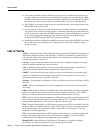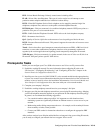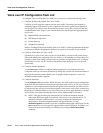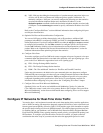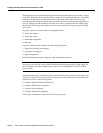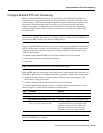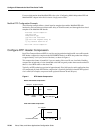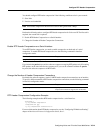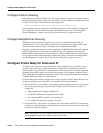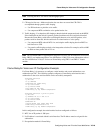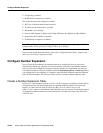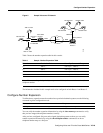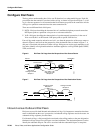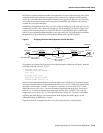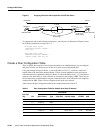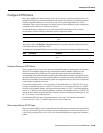
Configure Frame Relay for Voice over IP
VC-22
Voice, Video, and Home Applications Configuration Guide
Configure Custom Queuing
Some QoS features, such as IP RTP reserve and custom queuing, are based on the transport protocol
and the associated port number. Real-time voice traffic is carried on UDP ports ranging from 16384
to 16624. This number is derived from the following formula:
16384 = 4(number of voice ports in the Cisco 3600 series router)
Custom Queuing and other methods for identifying high priority streams should be configured for
these port ranges. For more information about custom queuing, refer to the “Performing Basic
System Management” chapter in the Configuration Fundamentals Configuration Guide.
Configure Weighted Fair Queuing
Weighted fair queuing ensures that queues do not starve for bandwidth and that traffic gets
predictable service. Low-volume traffic streams receive preferential service; high-volume traffic
streams share the remaining capacity, obtaining equal or proportional bandwidth.
In general, weighted fair queuing is used in conjunction with Multilink PPP with interleaving and
RSVP or IP Precedence to ensure that voice packet delivery. Use weighted fair queuing with
Multilink PPP to define how data will be managed; use RSVP or IP Precedence to give priority to
voice packets. For more information about weighted fair queuing, refer to the “Performing Basic
System Management” chapter in the Configuration Fundamentals Configuration Guide.
Configure Frame Relay for Voice over IP
You need to take certain factors into consideration when configuring Voice over IP for it to run
smoothly over Frame Relay. A public Frame Relay cloud provides no guarantees for QoS. For
real-time traffic to be transmitted in a timely manner, the data rate must not exceed the committed
information rate (CIR) or there is the possibility that packets will be dropped. In addition, Frame
Relay traffic shaping and RSVP are mutually exclusive. This is particularly important to remember
if multiple DLCIs are carried on a single interface.
For Frame Relay links with slow output rates (less than or equal to 64 kbps) where data and voice
are being transmitted over the same PVC, we recommend the following solutions:
• Separate DLCIs for voice and data—By providing a separate subinterface for voice and data, you
can use the appropriate QoS tool per line. For example, each DLCI would use 32 kbps of a
64 kbps line.
— Apply adaptive traffic shaping to both DLCIs.
— Use RSVP or IP Precedence to prioritize voice traffic.
— Use compressed RTP to minimize voice packet size.
— Use weighted fair queuing to manage voice traffic.
• Lower MTU size—Voice packets are generally small. By lowering the MTU size (for example,
to 300 bytes), large data packets can be broken up into smaller data packets that can more easily
be interwoven with voice packets.
Note Some applications do not support a smaller MTU size. If you decide to lower MTU size,
use the ip mtu command; this command affects only IP traffic.



